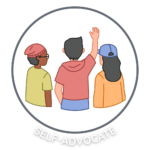
Self-advocacy is one of the most important skills high school students need, particularly those who have an Individualized Education Program (IEP). Learning to navigate their own IEP helps students take charge of their educational journey and ensures that they get the support they need. To make this process easier and more engaging for students, Everyday Speech has introduced two new social communication videos: one explaining the components of an IEP, and another guiding students on how to prepare for their IEP meetings. If you want to help students understand their IEP better, you’re in the right place.
In this blog, we’ll explore how these animated videos can support high school educators in teaching self-advocacy skills while ensuring students feel confident and prepared.
Why Teaching Self-Advocacy Matters for Students with IEPs
Understanding what’s in an IEP and how to speak up during an IEP meeting is crucial for students with disabilities. When students understand their own IEP, they become more active participants in their education. This self-awareness allows them to take ownership of their learning needs and advocate for the accommodations that help them succeed.
High school is a pivotal time for building these skills. Students will soon transition to post-secondary education or the workforce, where they’ll need to independently advocate for their accommodations. Introducing them to the contents of their IEP and guiding them on how to prepare for meetings is essential preparation for life beyond school.
Introducing Everyday Speech’s New IEP Videos
To help educators teach these important skills, Everyday Speech offers two brand-new animated social communication videos. These videos simplify the complex world of IEPs for students, making it easier for them to grasp the concepts and prepare for their meetings.
The first video covers what’s included in an IEP. Through animation, students learn about key components such as accommodations, goals, and personalized instruction. The animation makes it easy for students to follow along and understand terms that may feel overwhelming otherwise.
The second video focuses on how to prepare for an IEP meeting. It provides students with a step-by-step guide on how they can actively participate, what questions they should ask, and how to share their thoughts and concerns. This video empowers students by showing them that their voice matters in these meetings, giving them the confidence to speak up.
Breaking Down the IEP
One of the challenges students face when it comes to their IEP is understanding what it includes. Terms like “accommodations” and “goals” might seem intimidating or unclear, especially for younger middle school students who are new to this process.
The first video uses engaging animation to break down the essential components of an IEP in a way that’s accessible and relatable. Key terms are clearly defined, helping students understand how their IEP is structured and what each part means for them.
For example, the video explains that accommodations are specific changes made to the classroom or teaching methods to help the student learn, such as extra time on tests or access to assistive technology. Goals, on the other hand, are targets set by the IEP team that the student is working toward, and the video helps students understand why these are important for their personal growth.
By watching this video, students get a better understanding of their educational plan, helping them feel more in control of their learning experience.
Preparing for an IEP Meeting
Once students know what’s in their IEP, the next step is learning how to advocate for themselves in their IEP meetings. The second video provides practical strategies for students to prepare for these meetings and teaches them how to communicate their needs effectively.
This video is particularly valuable because many students may feel anxious or unsure about participating in meetings with teachers, parents, and administrators. Through step-by-step instructions, the animation guides students on how to prepare by:
- Reviewing their IEP before the meeting.
- Thinking about what accommodations or goals have helped them and what might need to be adjusted.
- Practicing ways to respectfully ask questions or share their concerns during the meeting.
The video encourages students to recognize that the IEP meeting is an opportunity for them to be heard. It also reinforces that self-advocacy is a skill that can be learned and developed over time.
Unlock all of our new Self-Advocacy materials by signing up for your free trial today – no credit card required!
Access the full Social Communication Curriculum HERE!
Instant access to thousands of no-prep social skills activities, over 1000+ video lessons, and engaging games designed to enhance learning and development.
Why Choose Everyday Speech’s IEP Videos
Everyday Speech’s IEP videos are more than just educational—they’re empowering. The animated and live-action videos ensure the material is engaging, while the practical advice provided in the videos helps students feel confident.
Additionally, these resources are available with a free trial for educators who want to explore more. The videos are part of Everyday Speech’s commitment to providing schools with high-quality, research-based social communication tools.
Conclusion
Teaching self-advocacy is a critical component of helping students with IEPs succeed. Everyday Speech’s new social communication videos make this process easier. By guiding students through an IEP and meeting, educators can help students feel confident in advocating for themselves.
Start using Everyday Speech’s videos today to help students understand their IEP and build self-advocacy skills. Whether you’re preparing students for their first IEP meeting or helping them navigate accommodations, these videos an amazing tool. Stay tuned for more self-advocacy materials on the blog.
Related Blog Posts:
Navigating Middle School: Enhancing Social Skills Through Videos
Teaching Middle School Students to Stay Calm and Solve Problems
Promoting Mental Well-being: SEL Lessons for Middle School Students





